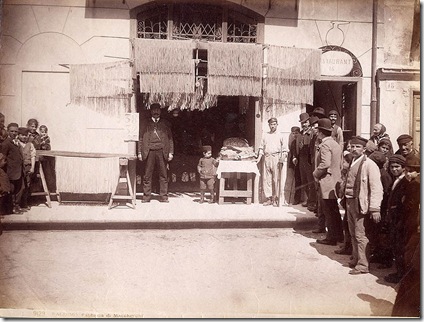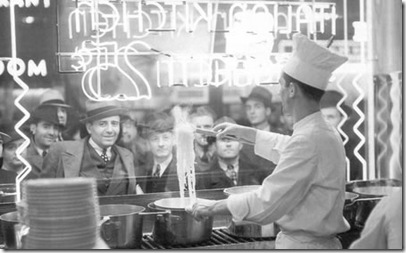La Storia della Pasta part – 4 Posted by Serena on Nov 23, 2010 in Uncategorized
Gragnano – Città della Pasta
No journey through the history of pasta would be complete without paying a visit to Gragnano, ‘Città della Pasta’ (‘pasta town’). Located in Provincia di Campania, just 33 kilometers south of Napoli, Gragnano has long been famous for its large scale production of excellent pasta. Gragnano took its first steps towards becoming an important centre of pasta production in the sixteenth century when several ‘pastifici a conduzione familiare’ (family based pasta manufacturers) developed their trade in the town.
Two factors played a very important role in the development of Gragnano’s pasta industry: 1. the climatic conditions of the region which, due to a light humid air, allowed the slow essiccazione (drying) of the pasta, and 2. the availability of water power to drive i mulini ad aqua (the water mills) which ground the grain into that most essential of ingredients: semola di grano duro (durum wheat flour). Between the end of the Cinquecento (1500’s) and the first decade of the Seicento (1600’s), some thirty water mills were constructed in Gragnano, the romantic ruins of which can still be admired today in the so called Valle dei Mulini (Valley of the Mills).
From the Seicento (1600’s) onwards, the majority of Gragnanesi (inhabitants of Gragnano) were involved in the production of ‘l’oro bianco’ (‘the white gold’). At that time Gragnano was already well known as a producer of fine textiles, an industry which went into gradual decline until, in 1783, a blight destroyed all the silkworms, finally bringing production to an end. Gragnano’s ‘Epoca d’Oro’ (Golden Age) took place nell’Ottocento (in the 1800’s) after the demise of the textile industry. During this period large industrial pastifici sprung up along Via Roma and Piazza Trivione, the area which was to become the very heart of the town. Along these streets the pastifici hung their pasta out to dry in front of their establishments.
With the large scale growth of the pasta industry, specialist workers appeared, such as the spannatori who cut the pasta and hung it up to dry on le canne (the canes), and the aizacanne who were particularly adept at carrying pasta by hand without letting it get stuck together.
At the time of Italy’s unification in 1861 Gragnano’s economy depended almost entirely on the output of its roughly 100 pastifici, whose total production amounted to around mille quintali (100,000 kilos) of pasta a day! Italy’s unification brought about the opening up of new markets in big cities such as Firenze, Torino, and Milano.
The power of Gragnano’s pasta industry in the Ottocento can be judge by the following interesting facts:
1. It was the pasta manufacturers themselves, and not the local council, who paid for the streets to be kept clean, thereby maintaining the hygienic conditions needed in order to hang the pasta outside to dry.
2. ‘La strada dei Maccheroni’ (‘Macaroni Street’), in the centre of Gragnano, was redesigned by architects whose aim it was to determine the optimum width of the street in relationship to the height of the buildings, thus allowing the pasta to benefit from the maximum amount of sun and heat at any given time during the day.
3. A new railway station was opened at Gragnano specifically to facilitate the easy transportation of pasta to Napoli, and hence the rest of Italy. The inauguration ceremony took place on the 12th May 1885, and was attended by niente po’ po’ di meno che (none other than) Re Umberto I (King Umberto the 1st) and his wife La Regina Margherita di Savoia (Queen Margherita of Savoia)!
Gragnano’s preeminence as a centre of pasta production lasted until the mid 1930’s when Mussolini, battling against the various embargoes imposed on Italy at that time, declared a policy of ‘produzione autarchica’ (self sufficient production), effectively blocking Gragnano’s pastifici from exporting pasta, and importing grain from the American and Ukrainian wheat fields. The advent of la Seconda Guerra Mondiale (the second world war) accentuated the crisis and many pastifici were forced to close down due to strong competition from pasta producers in other parts of Italy.
Today, Gragnano is still famous for its excellent pasta. The gramola, a wooden knife with a long handle which was used to work the semola (coarse wheat flour) until it became elastic, and the torchio, a cylindrical wooden press which forced the pasta through la trafila which gives it its form, have been replaced by powerful and sophisticated computerized machines capable of producing 20 quintali (1 quintale = 100 kilos hence 20 quintali = 2,000 kilos) of pasta an hour.
Certe cose, comunque, non cambiano mai, e quella famosa aria di Gragnano continua ancora a fare miracoli sulla pasta. (Some things, however, never change, and the famous Gragnano air still continues to work its magic on the pasta).

Build vocabulary, practice pronunciation, and more with Transparent Language Online. Available anytime, anywhere, on any device.






Comments:
Edoardo:
Grazie tante, Serena per questa bella storia che io non conosceva. Saluti. Edoardo
Jeannet Mulder:
Ah! – all that manna comes from Granano!
Buongiorno en grazie mille Serena, for this interesting story.
We will eat our Margerhita’s and the extending likes with even more pleasure ; )
Saluto
Jeannet
stefania:
No ho saputo che la storia della pasta è così interessante, Grazie : )
dove hai trovato le informazioni?
Saluti,
Stefania
Serena:
@stefania Salve Stefania, ce n’è ancora tanta d’informazione sulla pasta! L’ho dovuta semplificare parecchio, ma ho trovato la maggior parte dell’informazione su diversi siti internet. È stato un bel lavorone!
Se vuoi saperne di più prova questa pagina:http://it.wikipedia.org/wiki/Pasta
Saluti da Serena